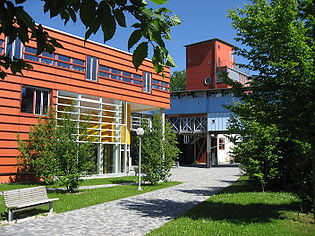University of Ulm
Universität Ulm | |
| Seal of the University | |
| Motto | Sciendo - Docendo - Curando |
|---|---|
| Type | Public |
| Established | 1967 |
| President | Karl Joachim Ebeling |
| Students | >8,000 (2010/11)[1] |
| Location | , Germany |
| Website | http://www.uni-ulm.de/en/home.html www.uni-ulm.de] |


The Ulm University (German: Universität Ulm) is a public university in the city of Ulm, in the South German state of Baden-Württemberg. The university was founded in 1967 and focuses on natural sciences, medicine, engineering sciences, mathematics, economics and computer science. With over 8,000 students, it is one of the smaller universities in Germany. Nevertheless, it frequently ranks as one of the top schools in natural sciences in domestic rankings. The campus of the university is located north of the city on a hill called Oberer Eselsberg, while the university hospital has additional sites across the city.
Concept and history
The university is the youngest public university in the state of Baden-Württemberg, which boasts several old, renowned universities in Heidelberg (founded in 1386), Freiburg (1457) and Tübingen (1477). The idea was to create a university with a new approach in both research and teaching. An important concept since the foundation of the university has always been to promote interdisciplinarity. In the decades following the foundation, the spectrum of subjects has steadily been extended, and the university has grown significantly. It is regarded one of the best universities in the world in the field of Optoelectronics, RF Circuit Design, Microelectronics. It also ranks among the top five universities in Germany for Electrical Engineering and Computer Science.
An important step in combining the strength of industrial and academic research was the realization of the idea of a "science city" around the main university campus. Research centers of companies like Daimler, Nokia, and Siemens have been established at the site, in addition to institutes of the university focusing on applied research. Among other large research projects, the university features four Collaborative Research Centers (German: Sonderforschungsbereiche),[2] which are established on a competitive basis by the German Research Foundation (Deutsche Forschungsgemeinschaft, DFG). Third-party funding of research reached 67.5 million euros in 2009.[2]
In 1998, Ulm University introduced an International Masters program in English: M.Sc. in Communication Technology, which is the first of its kind in Germany. Since then, this program attracts the very best students from different countries around the world. C-Tech Program has research collaboration with many renowned Universities around the world.
It also offers other English programs, namely M.Sc. and Ph.D. in Molecular Medicine, M.Sc. in Advanced Materials, M.Sc. in Energy Science and Technology, M.Sc. in Finance, M.Sc. in Biology and M.Sc. in Advanced Oncology, the latter being an extra-occupational program.[3]
In 2003, the Ulm University was involved in founding a private university in Egypt, the German University in Cairo.
Since 2007, the university has been participating in the German Universities Excellence Initiative with the newly founded International Graduate School in Molecular Medicine Ulm.[4]
Name of the university
As Albert Einstein was born in Ulm in 1879, it was suggested repeatedly that the university be named after him. In November 2006, the senate of the university finally decided to rename the university.[5] As this decision was however not confirmed by the Ministry of Science, Research and Arts of the State of Baden-Württemberg, the university will not be called Albert Einstein University Ulm (German: Albert-Einstein-Universität Ulm) as of July 2007 but simply Ulm University. However, the street on which the main buildings of the Ulm University are located - and thus, the physical address of the university - is called Albert-Einstein-Allee in honor of the great physicist.
Structure
The university is composed of four divisions, which in German universities traditionally are called faculties, and separate institutes. The four faculties are the medical faculty, the engineering and computer science faculty, the natural science faculty and the mathematics and economics faculty. A university hospital is associated with the medical faculty.[2]
University Library
The Library of the Ulm University is located in a new building on the main campus and features close to 1 million volumes.
Points of interest
- Botanischer Garten der Universität Ulm, the university's botanical garden
External links
- Homepage of the Ulm University (in German)
- Partnership with the German University in Cairo (in English)
- Spiegel Ranking (2004) Mathematics (in German)
References
- ^ "Uni mit neuer Rekordmarke: Erstmals mehr als 8000 Studenten eingeschrieben" (Press release). Ulm University. 18 October 2010. Retrieved 21 October 2010.
- ^ a b c Ulm University. "Annual Report 2009" (PDF). Retrieved 7 October 2010.
- ^ "Programmes of Study in English". 13 August 2010. Retrieved 1 October 2010.
- ^ DFG, German Research Foundation (9 September 2010). "Current Graduate Schools". Retrieved 1 October 2010.
- ^ "Neuer Name zum Jubiläum: Albert-Einstein-Universität Ulm" (Press release). idw. 16 November 2006. Retrieved 7 October 2010.
